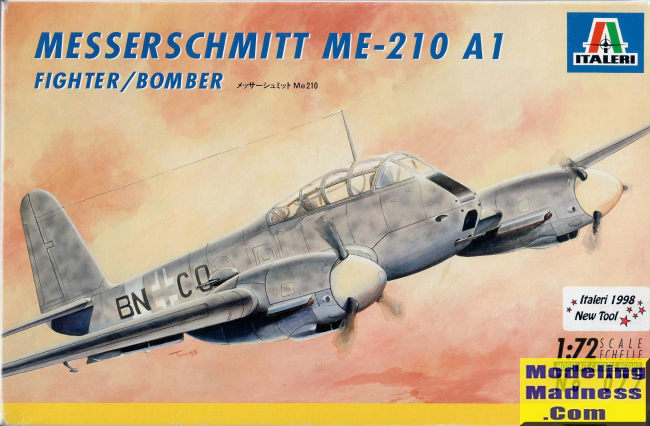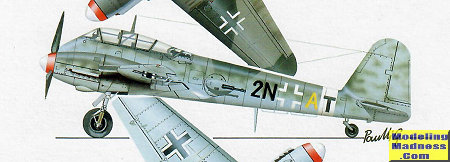
| KIT #: | 077 |
| PRICE: | $10-20 used |
| DECALS: | Two options |
| REVIEWER: | Tom Hall |
| NOTES: | 1998 release. Long fuselage version. |

| HISTORY |
The Internet presents a fuzzy picture of the Me 210. It was planned as a heavy fighter and dive bomber. In 1939 and 1940, roughly a dozen versuch (experimental, “V”) planes were built, and most or all had DB 601 A engines. A tendency to yaw was solved quickly with a single fin and rudder, but longitudinal instability and wicked stalls took much longer to solve.
The wing had two different angles at the leading edge. The trailing edge, also, was not straight, contrary to some published drawings. The unusual planform was suspected of causing some of the undesirable stalling characteristics.
In 1941, V-14 was completed to test a drogue parachute. V-16 became the first A-0. (See http://www.lexikon-der-wehrmacht.de/Waffen/Me210.htm. ) The A-0 is the pre-production variant, and it evidently had the new, more powerful DB 601 F engines, which first became available in 1941. They were chosen for the 210 to improve its disappointing speed. (“A-0” may signify the new engine, but references are vague about that. William Green placed the first A-0 in 1940, before the DB 601 F engine.) Production of the A-0 ended in 1941.
Also in 1941, production of both A-1 and A-2 variants began, and one or two B-1 reconnaissance planes were completed. The A-1 was a heavy fighter. The A-2 had dive brakes and external bomb racks. It appears that in 1941, 94 210 V, 210 A and 210 B planes were delivered. Some went to Erprobungsstaffel 210, a unit formed to service-test the 210.
The new DB 601 F engine was not the most reliable and its problems added to the list. The accident rate became unacceptable. It included the death of the CO of Erprobungsstaffel 210, Oberleutnant Heinz Forgatsch, in September 1941.
The longitudinal stability (pitch) problem persisted. To solve it, Messerschmitt lengthened the rear fuselage of Me 210 A-0 NE+BH by 92 cm (36.2 inches) in March 1942 and gave it versuch number "V-17". However, at around the same time, an order suspended production at the two factories (Augsburg and Regensburg). It was decided to develop a new variant of the Bf 110 as a stopgap measure and think about what to do with the considerable amount of 210 work in progress.
On the basis of an April 1942 report that the lengthened fuselage improved longitudinal stability, production of partially built 210 A’s resumed, but the long fuselage was installed on them. The aircraft continued to be designated A-1 and A-2, and the new fuselage was called “lang” (long).
In July 1942, a 210 was experimentally fitted with leading-edge slats (not slots, which are fixed). The slats were the automatic type, spring-operated, held flush with the leading edge of the wing by relative wind. When airspeed slows, relative wind pressure decreases and the slats spring forward to increase lift. Planes so equipped usually have the slats extended when not in flight. Slats were apparently fitted to dozens of 210 A’s and probably made slow turns safer.
There are mentions of failures of main landing gear, but few specifics.
(In 1942, the prototype V-27 (the 18th and final 210 V) proved a pairing of the longer airframe and new DB 605 engines. The result was designated Me 210 C. It was decided to place its mass-production with a Hungarian firm, and the license-built machine was designated Me 210 Ca-1. It is thought that only 95 210’s were built in 1942. Almost all were A-1’s and A-2’s. A-1/A-2 production apparently ended by the year’s end to change over to the 410.)
The 210 saw limited combat against the British Isles, beginning in 1942. It had a longer combat career on the Eastern Front and in the Mediterranean.
| THE KIT |
 This
is not a complicated kit and is not to be confused with the Bilek kit.
This
is not a complicated kit and is not to be confused with the Bilek kit.
The box art shows two protruding nose guns, which are incorrect for the typical 210. Marketed as an A-1, Italeri’s kit is closer to an A-2 due to all of the bombs and bomb racks provided, and some scribing on the wing upper surface that apparently represents folded dive brakes.
This kit is a lang. When built, it will be approximately 171 mm long. That scales up to 12.31 m in full size, which is longer than the 12.12 m of the A lang! (Italeri released an Me 410 the following year as kit 074, and they used the same fuselage tree but added length at the front of the engine nacelles. Therefore, the excess 3 mm may be on the fuselage of their 210.)
We can open the bomb bay by cutting the doors apart. The outboard nose guns are represented with indentations, but the inboard ones are omitted! The cockpit is eight pieces, basic shapes in basically the right places. No roll bar. No aircrew. A panel in the cockpit has been split at the centerline and its two halves do not align. The canopy is split at the centerline.
Per a movie of a new 210 on YouTube, the trailing edge of the wing had an angle of roughly 178 degrees at the inboard flap. Italeri made a more noticeable angle, but we can live with that, right? Unfortunately, separate wing slats are not provided, even though they may be needed to depict a plane on the ground. The closed landing gear doors need scribing to show their edges. The prop blades lack twist. None of the control surfaces is molded separately.
 Decals are
BN+CO of Zerstörergeschwader 2, and 2N+AT of Zerstörergeschwader 8. No swastikas
are included.
Decals are
BN+CO of Zerstörergeschwader 2, and 2N+AT of Zerstörergeschwader 8. No swastikas
are included.
The instruction sheet gets a “B+”. The painting suggestions would have us two-tone the cockpit in flat black and sage green! Italeri also steers us towards an unusual splinter scheme in the Model Master versions of FS 34092 (dark spruce green) and FS 35237 (gray), with sides and underside in FS 36375 (gray), unlike the box art. Instruction about decal placement is good.
| CONCLUSIONS |
This is a fairly good kit of a troubled design in recovery. It’s affordable. Because the 210 is not likely to become a popular subject, Italeri’s kit will probably be the best one in 1/72 scale for at least another few years. (A build review of this kit has been archived at http://www.modelingmadness.com/review/axis/luft/me210.htm.)
| REFERENCES |
Goss, Chris, “Hornet Without a Sting”, FlyPast, April 2017.
Green, William, Warplanes of the Second World War, Fighters, Vol. 1, Doubleday & Co., 1967.
http://www.lexikon-der-wehrmacht.de/Waffen/Me210.htm
Luftwaffe Resource Center: http://www.warbirdsresourcegroup.org/LRG/me210-gallery.html
Walkaround footage: https://www.youtube.com/watch?v=risXViF3pIk
War Thunder: https://forum.warthunder.com/index.php?/topic/170138-the-hungarian-me-210-ca-1-multi-role-aircraft/page/2/
April 2019
Copyright ModelingMadness.com. If you would like your product reviewed fairly and fairly quickly, please
contact
the editor or see other details in the
Note to
Contributors. Back to the Main Page
Back to the Review
Index Page
Back to the Previews Index Page